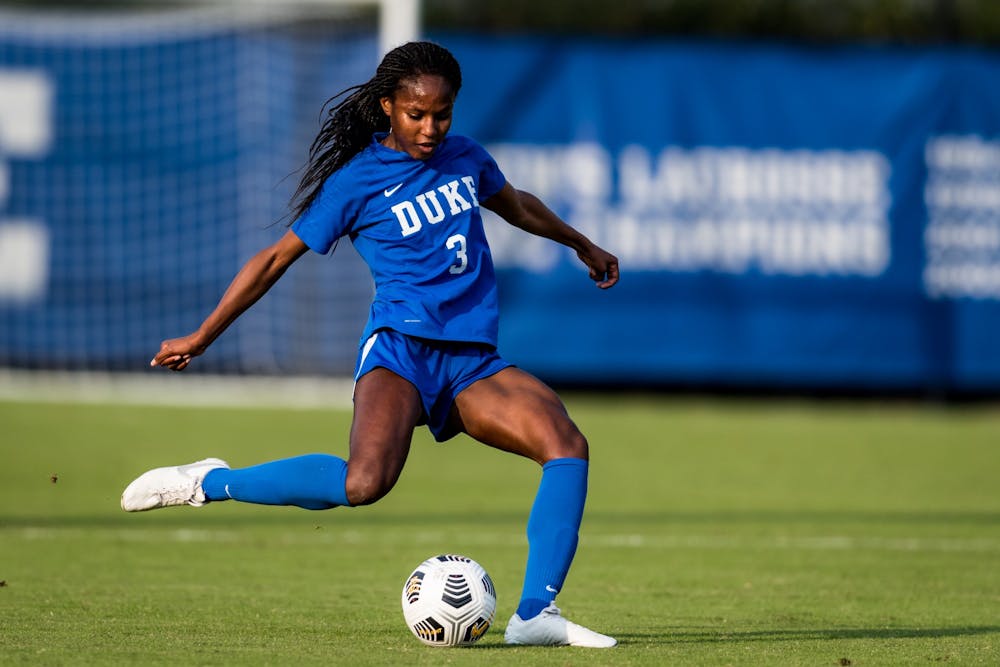Two weeks ago, Duke kicked its schematic aggression into overdrive, fundamentally altering the identity of the team.
Blue Devil fullbacks have always pushed farther up the field than what a normal 4-3-3 formation would call for. But with a few games under the team's belt in 2020, head coach Robbie Church clearly felt comfortable trying something new.
Church is generally a bit shy about getting too specific when he describes his schemes. Following Duke's season-opening win at Wake Forest, he said, “[We’re] comfortable with changing. We can do things on the fly. We can move people on the fly, and do things with the formation. And that’s an advantage of having a veteran team.”
That quote undersells things. After Sophie Jones and Mia Gyau suffered season-ending injuries last September, Duke went through near-weekly schematic changes in an ultimately futile attempt to spark consistent offense. And it started this season in a fairly mundane 4-3-3.
“We’ll look at different formations,” Church told The Chronicle before the 2020 fall season. “But I think it's how we play the 4-3-3. We had to fall a little deeper last year than we wanted to fall. We want to play a little bit higher this year somewhat. So we’ll play a lot of the 4-3-3, but we’ll play it a different way, too. We’re still trying to sort that out.”
Over a month later, and he hasn’t just sorted it out—he’s almost created a new system.
To radically oversimplify soccer formations, the most common systems are the 4-3-3 and the 4-4-2. The 4-4-2 is generally the most balanced, though a collegiate team without the talent to play a 4-3-3 is a poor one. The Blue Devils have mostly played variants on the 4-3-3 since 2017, but starting with their 0-0 tie in a rematch with Wake Forest two weeks ago, Church has taken the two fullbacks and turned them into wingbacks.
A 4-3-3 with two wingbacks is almost unheard of. By pushing those backs across the whole length of the field, it requires an enormous amount of stamina from them, as well as a skill set as versatile as that of a box-to-box midfielder. And while it provides a possibly overwhelming amount of offensive support, it entrusts just three players to stop the opponent’s counters.
For the Blue Devils, however, those three players might be some of the best in the country at their respective positions. Taylor Mitchell, though unheralded, is one of the best collegiate centrebacks, while her back-mate Caitlin Cosme has recently blossomed into an elite defensive force as well. And now-full-time starter Ruthie Jones has completed this group with incredible instincts and athleticism in the net.
The shot numbers from recent games don’t pop off the page, and though that’s certainly a problem in its own right, the eye test shows a different story. When wingbacks Gyau and Emily Royson have pushed in the opposing half, they’ve forced the other team to collapse inwards defensively and give Duke long swaths of uncontested possession. These chances are sure to get converted into goals more often as this team develops and as everyone gets more comfortable in their current roles.
What’s particularly notable about Church’s wingback-4-3-3 is how it’s obfuscated postgame stats. Duke was outshot 10-5 in its win against No. 3 Clemson Sunday, but to say the Blue Devils just got lucky would be wildly off-base. Their style has meant that they take long possessions instead of trying quick strikes, while their defense forces desperate shots and smothers team play. When an opponent is faced with the decision to try to beat Gyau off the dribble, attempt a pass through Mitchell and Sydney Simmons or pray for a lucky strike, the latter tends to be the most worthwhile option.
Perhaps most important for the long-term prospects of the program, this wingback-4-3-3 relieves Duke of positional inequity. A traditional 4-3-3 would turn the Blue Devils' recruiting patterns (two forwards committed since 2017 vs. five defenders) into a major problem. But now freshmen Royson and Olivia Migli are contributing on both sides of the pitch. Assuming that Duke's chemistry in the attacking third will improve as it plays more in this system, high-quality shots will soon follow, and the Blue Devils will soon be an even more exciting and enticing team.
Get The Chronicle straight to your inbox
Signup for our weekly newsletter. Cancel at any time.

